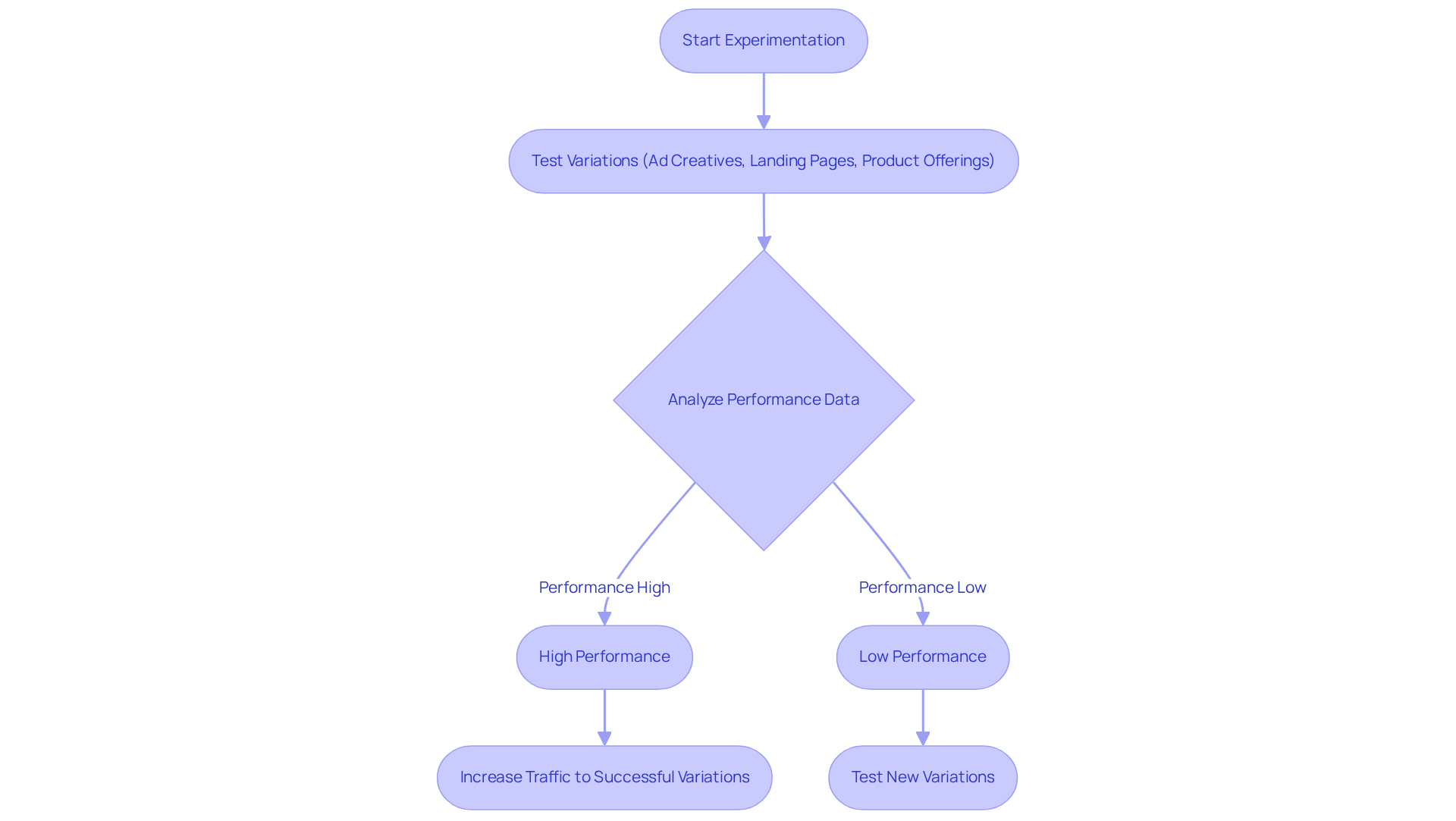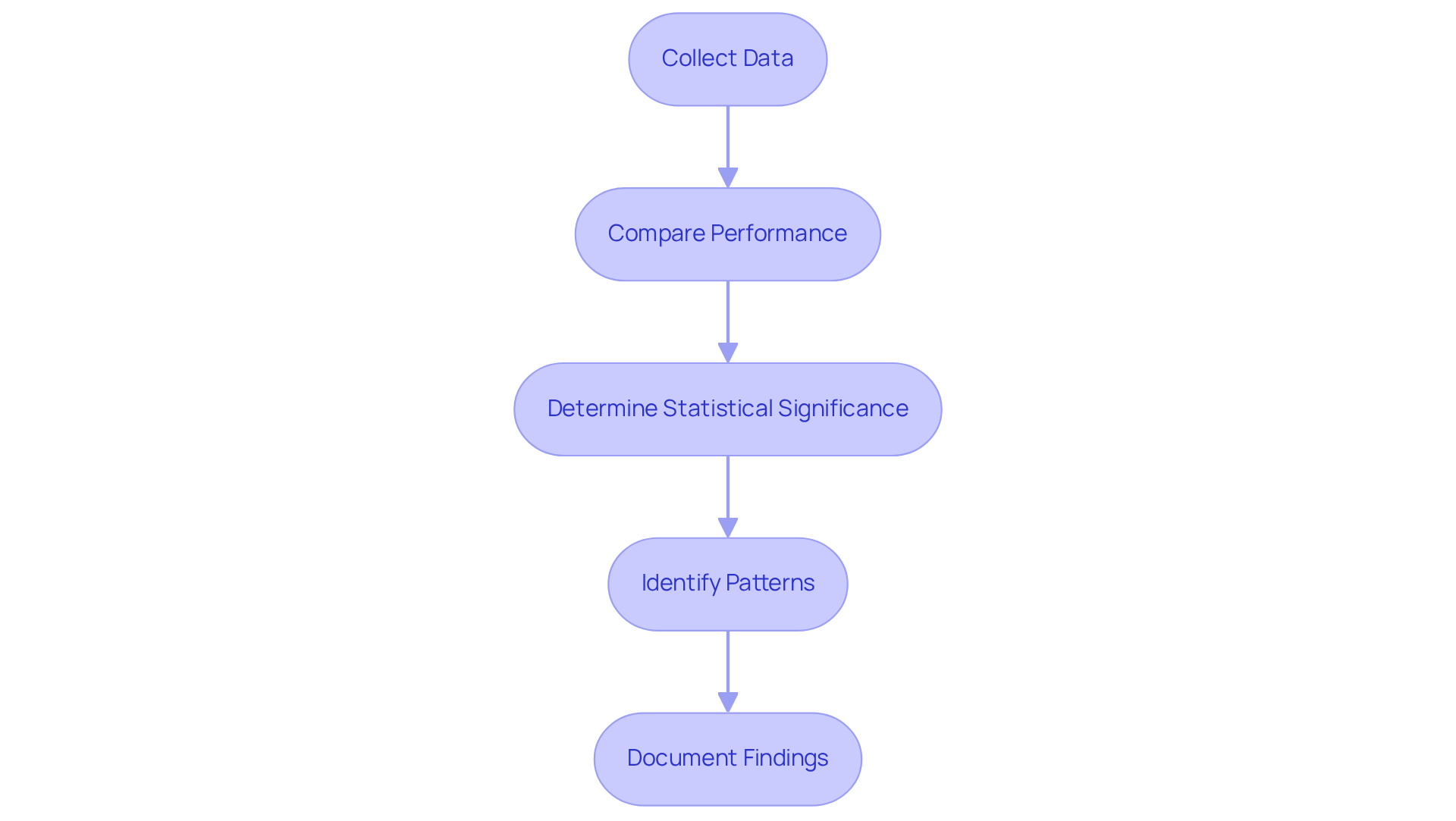
Overview
The multi-armed bandit test stands as a powerful dynamic optimization method, specifically designed to empower direct-to-consumer (DTC) brands in refining their marketing strategies. By effectively balancing exploration and exploitation, this approach maximizes conversions, making it an essential tool for brands aiming to thrive in a competitive landscape.
To implement this test successfully, it’s crucial to adopt a structured approach. Start by clearly defining your objectives; this sets the foundation for your testing strategy. Next, select the variables that will be tested, ensuring they align with your goals. Finally, analyze the results meticulously. This continuous refinement process, driven by real-time performance data, allows brands to adapt and enhance their marketing efforts dynamically.
Incorporating the multi-armed bandit test into your marketing strategy not only boosts conversion rates but also fosters a culture of data-driven decision-making. By embracing this method, DTC brands can stay ahead of the curve, ensuring their marketing strategies are not just reactive but proactively optimized for success.
Introduction
The dynamic landscape of direct-to-consumer (DTC) marketing demands innovative strategies that can adapt in real-time. Enter the multi-armed bandit test—a game-changing approach that empowers brands to optimize their marketing efforts by striking a balance between exploring new ideas and exploiting proven successes. Yet, many DTC brands find themselves grappling with the effective implementation of this testing method, unsure of how to leverage its full potential.
What are the key steps needed to master the multi-armed bandit test? How can brands ensure they are making data-driven decisions that lead to sustained success? By understanding and applying this powerful strategy, brands can not only enhance their marketing effectiveness but also secure a competitive edge in an ever-evolving market.
Understand the Multi-Armed Bandit Concept
The multi armed bandit test serves as a powerful dynamic optimization method that significantly enhances decision-making by expertly balancing exploration and exploitation. Imagine a bustling casino filled with various slot machines, each representing an 'arm' with an unknown payout rate. The goal? To maximize returns by continuously testing and selecting the best-performing options.
For direct-to-consumer (DTC) brands, this concept translates into a strategic approach to experimenting with various elements of marketing strategies—be it ad creatives, landing pages, or product offerings. By directing more traffic to the variations that yield the highest conversions, brands can effectively minimize wasted resources while maximizing profitability. This real-time adaptation based on performance data is crucial.
Consider a news website employing this method; it can swiftly identify which articles drive the most engagement, thereby optimizing content delivery. By understanding the multi armed bandit test concept, brands lay the groundwork for implementing efficient evaluations that lead to improved marketing strategies and enriched customer experiences.
In conclusion, embracing this approach not only empowers brands to make informed decisions but also positions them to thrive in a competitive landscape.

Set Up Your Multi-Armed Bandit Test
To effectively implement your Multi-Armed Bandit (MAB) test, follow these essential steps:
-
Define Your Objective: Clearly articulate your goals for the test, such as boosting conversion rates, increasing average order value, or enhancing customer engagement. A well-defined objective establishes the foundation for your evaluation strategy.
-
Select Variables to Test: Identify the specific elements you wish to experiment with. This may include variations in headlines, images, call-to-action buttons, or entire landing pages. Ensure these variables align with your defined objectives to maximize relevance.
-
Select an Evaluation Tool: Opt for a robust MAB evaluation platform capable of real-time data analysis and dynamic traffic allocation. Leading tools in 2025 include Google Optimize, Optimizely, and specialized MAB solutions that streamline the testing process.
-
Allocate Traffic: Determine how to distribute traffic among the different variations. A common strategy is to start with equal distribution, then adjust dynamically based on the performance of each variant, allowing for more efficient resource allocation.
-
Set Success Metrics: Establish clear success metrics to evaluate the experiment's effectiveness. This could involve specific conversion rates, revenue per visitor, or other key performance indicators (KPIs) that reflect your business goals.
-
Initiate the Experiment: After preparing everything, initiate your MAB experiment and observe its progress closely. Ensure you allow sufficient time for the assessment to gather meaningful data before drawing any conclusions.
By following these steps, you can leverage the advantages of the multi-armed bandit test evaluation, such as quicker results and enhanced engagement, ultimately driving better outcomes for your DTC brand.

Analyze Test Results for Insights
After conducting your multi armed bandit test, it is crucial to analyze the results for informed decision-making. Here’s how to do it effectively:
-
Collect Data: Start by gathering comprehensive data from your testing tool. Focus on key metrics such as conversion rates, click-through rates, and any other predefined success criteria. This foundational step sets the stage for meaningful analysis.
-
Compare Performance: Next, assess how each alternative performed against your success metrics. Identify which options achieved the highest conversions and which fell short. This clear performance comparison will guide your next steps in the context of a multi armed bandit test.
-
It’s essential to determine the statistical significance of your results in a multi armed bandit test. This ensures that observed differences are not merely due to random chance. Utilize statistical tools or calculators to establish significance levels, with a common threshold being a p-value of less than 0.05. This indicates a strong likelihood that your results are meaningful.
-
Identify Patterns: Analyze the data for trends, such as demographic responses to specific variations. Recognizing these patterns can direct future marketing approaches and enhance your targeting efforts, making your strategies more effective.
-
Document Findings: Finally, maintain a detailed record of your findings. Include successful elements, areas for improvement, and any unexpected insights. This documentation is invaluable for enhancing future evaluations and modifying strategies based on empirical evidence. By doing so, you not only solidify your current understanding but also pave the way for future successes.

Iterate and Optimize Based on Findings
Once you've analyzed your test results, it's time to iterate and optimize your approach:
-
Enhance Your Alternatives: Leverage the insights gained to refine your successful options. This might involve tweaking copy, changing images, or even testing new elements. However, proceed with caution; altering variations mid-experiment necessitates the multi armed bandit test to re-optimize its strategy, which could extend the experiment's duration by weeks.
-
Conduct new experiments by implementing fresh multi armed bandit test evaluations to explore different variables continuously. The optimization process is never truly complete; each test should build on the last. Keep in mind that MABs are designed to evaluate tradeoffs between all variations throughout the experiment's lifespan.
-
Monitor Performance: After making adjustments, closely monitor performance metrics such as Return on Ad Spend (ROAS) and Customer Lifetime Value (CLV). This ongoing evaluation is crucial to ensure that your changes yield improved results and contribute to sustained success.
-
Engage Stakeholders: Share your findings and optimizations with your team and stakeholders. Collaboration can spark new ideas and lead to further enhancements, driving collective success.
-
Stay Informed: Keep abreast of industry trends and advancements in Conversion Rate Optimization (CRO) methodologies. Continuous education will empower you to stay ahead of the competition and refine your strategies effectively.
By adopting these practices, DTC brands can harness the power of multi armed bandit test to elevate their marketing strategies and achieve significant performance improvements.

Conclusion
Embracing the multi-armed bandit test offers direct-to-consumer (DTC) brands a powerful strategy for optimizing their marketing efforts, striking a balance between exploration and exploitation. This dynamic optimization method empowers brands to make informed decisions that enhance customer experiences and boost profitability, positioning them for success in a competitive landscape.
Key steps for implementing a multi-armed bandit test include:
- Defining objectives
- Selecting variables
- Utilizing appropriate tools
- Analyzing results
Each stage contributes to a comprehensive understanding of how various marketing strategies perform, enabling brands to refine their approaches based on empirical evidence. Continuous iteration and optimization are crucial, underscoring that the testing process is an ongoing journey rather than a one-time effort.
DTC brands are urged to harness the power of multi-armed bandit testing to stay ahead of market trends and consumer preferences. By committing to this iterative process and leveraging data-driven insights, brands can enhance their marketing strategies and foster long-term growth and success. The future of effective marketing hinges on the ability to adapt and optimize continuously, making the multi-armed bandit test an invaluable tool in achieving these goals.
Frequently Asked Questions
What is the multi-armed bandit concept?
The multi-armed bandit concept is a dynamic optimization method that enhances decision-making by balancing exploration and exploitation, akin to testing various slot machines in a casino to maximize returns.
How does the multi-armed bandit concept apply to direct-to-consumer (DTC) brands?
For DTC brands, it serves as a strategic approach to experiment with marketing elements such as ad creatives, landing pages, and product offerings, allowing them to direct traffic to the variations that yield the highest conversions.
What are the benefits of using the multi-armed bandit method in marketing?
The method helps minimize wasted resources and maximize profitability by enabling real-time adaptation based on performance data.
Can you give an example of how a news website might use the multi-armed bandit concept?
A news website can use this method to quickly identify which articles drive the most engagement, allowing for optimized content delivery.
What is the overall impact of understanding and implementing the multi-armed bandit test?
Understanding this concept empowers brands to make informed decisions and positions them to thrive in a competitive landscape by improving marketing strategies and enhancing customer experiences.
FAQs











